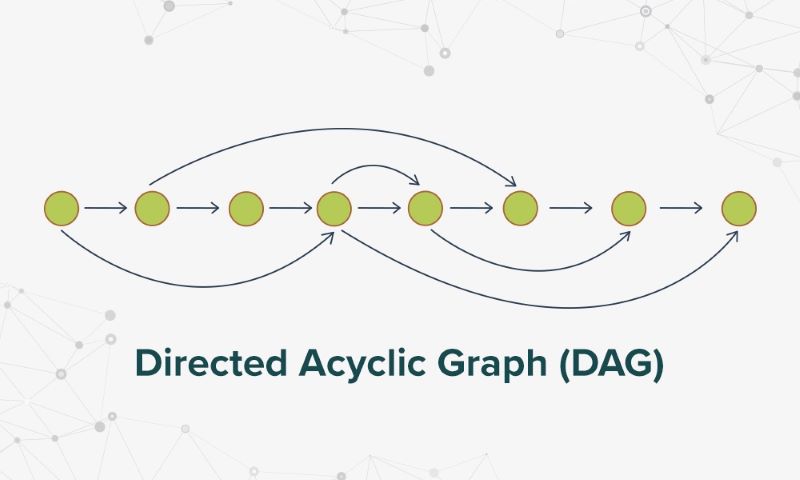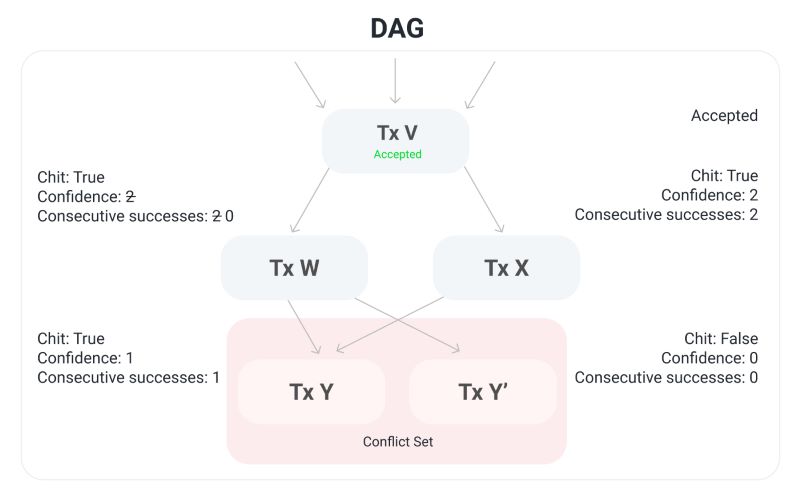In the ever-evolving landscape of distributed ledger technologies, the debate between DAG vs Blockchain has gained significant attention. While blockchain has been the cornerstone of decentralized systems, Directed Acyclic Graph (DAG) presents a compelling alternative that promises faster transactions and scalability. Curious about how these two technologies stack up against each other? Let’s dive into the key differences and advantages of each!
Understanding the Fundamentals
What is Blockchain?
At its core, blockchain is a decentralized ledger that records transactions in a linear chain of blocks. Each block contains a list of transactions, a timestamp, and a cryptographic hash of the previous block, ensuring integrity and security. This structure makes blockchain an ideal choice for applications requiring high levels of security and transparency, such as cryptocurrencies and supply chain management.
What is DAG?
Directed Acyclic Graph (DAG), on the other hand, is a more flexible architecture that allows for multiple paths for data to be recorded. Unlike blockchain’s linear structure, DAG enables transactions to be linked in a more complex network where each transaction can reference multiple prior transactions. This design leads to enhanced scalability and faster transaction speeds, making DAG an attractive alternative for real-time applications.
Key Differences Between DAG vs Blockchain
Structure and Scalability
The primary distinction between DAG vs Blockchain lies in their structural design. Blockchain operates on a linear model, which can become congested as the number of transactions increases. This bottleneck can lead to longer confirmation times and higher fees, especially in busy networks like Bitcoin.
Conversely, DAG allows for parallel processing of transactions. This means that as more transactions occur, the network can handle them simultaneously, significantly increasing throughput. For financial applications that require rapid transaction processing, DAG offers a compelling advantage.
Consensus Mechanisms
Consensus is a crucial aspect of both technologies. In blockchain, miners or validators confirm transactions based on protocols like Proof of Work (PoW) or Proof of Stake (PoS). This often involves considerable computational resources and can lead to energy inefficiencies.
DAG employs a different approach. Each transaction must confirm one or more previous transactions, creating a web of confirmations. This mechanism not only reduces the need for energy-intensive mining but also allows for instant confirmations, making it ideal for applications that require real-time data processing, such as IoT and financial services.
Security Considerations
When examining DAG vs Blockchain, security is a paramount concern. Blockchain’s structure inherently offers strong security features due to its immutability. Once a block is added to the chain, altering it would require redoing the entire chain, making fraud attempts exceedingly difficult.
DAG, while innovative, presents unique security challenges. The reliance on earlier transactions for confirmations can lead to vulnerabilities if those transactions are compromised. However, many DAG implementations are incorporating advanced cryptographic methods to enhance security, making them increasingly robust.
Use Cases
Both technologies have distinct use cases. Blockchain has found success in sectors requiring stringent security measures, such as finance, healthcare, and supply chain management. Its ability to provide transparent and verifiable records makes it an ideal choice for cryptocurrencies like Bitcoin and Ethereum.
DAG is emerging as a favored choice for applications requiring high throughput and low latency. Industries like telecommunications, real-time data sharing, and IoT can benefit from DAG’s architecture. For instance, projects like IOTA utilize DAG to facilitate microtransactions in IoT devices, highlighting its suitability for modern technological demands.
The Future: DAG vs Blockchain
Integration and Interoperability
As the demand for efficient and scalable solutions grows, the future will likely see increased integration of both DAG and Blockchain technologies. Financial institutions and tech companies are beginning to recognize the strengths of each and are exploring ways to create hybrid systems that leverage the advantages of both architectures.
Interoperability will be a key theme in the evolution of tech networks. By enabling different networks to communicate and share data seamlessly, businesses can enhance operational efficiency and expand their service offerings.
Regulatory and Compliance Factors
The rapid adoption of both technologies will necessitate regulatory frameworks that ensure security and consumer protection. As governments and regulatory bodies develop policies for cryptocurrencies and distributed ledgers, understanding the implications of DAG vs Blockchain will be essential.
Stakeholders must consider how regulations will impact the deployment and operation of these technologies, particularly in finance where compliance is critical. The ability to demonstrate transparency and security will be pivotal in gaining regulatory approval for innovative solutions.
Navigating the Future of Tech Networks
The discussion of DAG vs Blockchain is not merely academic; it represents a fundamental shift in how we approach technology in finance and beyond. As we move towards a more decentralized future, both architectures will play integral roles in shaping the landscape of digital transactions and data management.
As a seasoned professional in the field, I urge stakeholders to stay informed about these technologies and their implications. By understanding the strengths and weaknesses of both DAG and Blockchain, businesses can position themselves to leverage these advancements effectively. The future is bright for tech networks, and those who adapt will undoubtedly lead the way.
As we explore the dynamic landscape of DAG vs Blockchain, it’s clear that both technologies offer unique advantages that can revolutionize the way we conduct transactions and manage data. Blockchain’s robustness and security make it ideal for applications demanding transparency and trust, while DAG’s speed and scalability position it as a game-changer for real-time processing in modern industries.
In a world increasingly reliant on digital solutions, understanding these technologies is crucial for businesses looking to innovate and thrive. The future will likely see a convergence of both approaches, allowing organizations to leverage the best of each to create more efficient, secure, and user-friendly systems.
Discover in-depth resources and case studies on the benefits and applications of both DAG and Blockchain technologies at Blockchain Global Network!
Q&A
- What is the difference between a DAG and a blockchain?
A Directed Acyclic Graph (DAG) differs from a traditional blockchain in its structure and approach to achieving consensus and recording transactions. While a blockchain arranges data in a linear sequence of blocks, a DAG has a tree-like structure where transactions are linked to multiple other transactions, eliminating the need for blocks and the chain structure. This can potentially allow for faster transaction times and increased scalability.
- How does a DAG improve upon blockchain technology?
DAG technology can potentially improve upon blockchain by offering faster transactions and better scalability. Since DAGs don’t require blocks to be mined, transactions can be processed individually and in parallel, reducing the confirmation times. Furthermore, the DAG structure can decrease network congestion and minimize transaction fees as the network grows, addressing some of the common bottlenecks faced by traditional blockchains.
- Are DAG-based cryptocurrencies more efficient than blockchain-based ones?
DAG-based cryptocurrencies are often touted as more efficient than traditional blockchain-based ones in terms of transaction speed and scalability. Because they do not require mining and block confirmations, DAG-based networks can process transactions almost instantaneously. However, efficiency also depends on network design and the specific use case, so while DAGs may have advantages, they may not be suitable for all applications.
- Can DAGs and blockchains coexist in the cryptocurrency ecosystem?
Yes, DAGs and blockchains can coexist in the cryptocurrency ecosystem as they serve different purposes and can be optimized for various use cases. While blockchains are valued for their security and decentralized features, DAGs are appreciated for their scalability and speed. Developers may choose the appropriate technology based on the requirements of their particular project or application.
- What are the security implications of using a DAG over a traditional blockchain?
The security implications of using a DAG instead of a traditional blockchain revolve primarily around the consensus mechanism and how transactions are confirmed. Without the rigorous proof-of-work or proof-of-stake mechanisms typical in blockchains, DAGs may employ alternative approaches to ensure transaction integrity and network security. As a result, while DAGs may offer performance benefits, the security models may differ and must be thoroughly evaluated in the context of the specific application they support.




RELATED POSTS
What is Stacking in Crypto and Why It Matters
"What is stacking in crypto?...
Blockchain Revolution: Safekeeping Educational Data in the Digital Age
Embrace blockchain's impact on educational...
Revolutionizing the Classroom: How Blockchain Will Transform Education
Enhance education with blockchain! Strengthen...
Tellor (TRB Crypto): A secure oracle solution for DeFi
In the blockchain world, accessing...
Bitcoin Charlotte and 3 Expected Growth Signals
Bitcoin Charlotte is not just...
What is KYC in Crypto? The Key to safer and transparent trading
What is KYC in Crypto...
Can you short Bitcoin? – Exploring the Secret
Can you short Bitcoin? This...
Unveiling the secrets of blockchain technology meaning
What if the key to...
How does Robinhood work? The Gateway to Blockchain
In today’s rapidly evolving financial...
Exploring the Growth of the Blockchain Technology Market in 2024
The blockchain technology market is...
Elastic Chain: The future of Layer-2 Blockchain networks
Elastic Chain ushers in a...
How Base L2 Sequencers are enabling the next generation of blockchain innovation
The evolution of blockchain technology...
Blocksense Network Airdrop – Hunt for Airdrop Tokens Ahead of Mainnet 2025
The Blocksense Network airdrop is...
What can you get with leetcoins? Discover now!
What can you get with...
Exploring the Bitcoin Halving Cycle – Future and Price Predictions
Exploring the Bitcoin Halving Cycle...
Unlocking the Mystery: Who is Satoshi Nakamoto Really?
Who is Satoshi Nakamoto? Tracing...